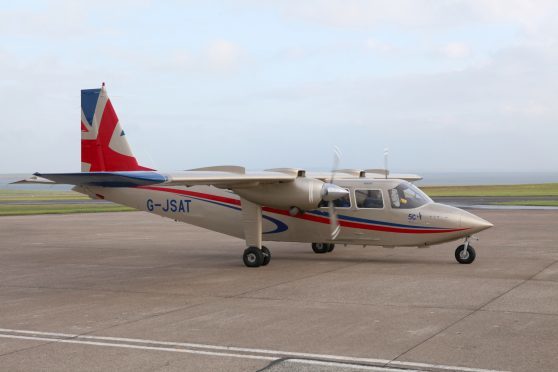Pilots, airport bosses and politicians gathered in Orkney yesterday to celebrate the 50th anniversary of airline Loganair’s inter-island service.
The company was created in 1962, and started conveying passengers between the Orkney islands five years later, as the prelude to expanding to Shetland three years later.
Since then, Loganair has grown considerably, with bases in Aberdeen, Inverness, Dundee and Edinburgh providing flights as far afield as Jersey, Dublin and Bergen.
The company also boasts the world record for providing the shortest scheduled passenger flights in the world, which take an average of just 90 seconds.
The distance between the airfields at Westray and Papa Westray is 1.7miles, the equivalent of the length of the runway at Edinburgh Airport.
The fastest flight recorded was just 53 seconds while yesterday morning’s quick trip clocked in at 85.
Billy Muir worked as Orkney Islands Council’s transport representative when the first Loganair flight arrived on the islands.
He said: “The record-breaking short flights are great for publicising the islands.
“The plane is in the air for less than two minutes, and it’s brilliant.”
All of the inter-island flights use the same model of aircraft, the Islander.
Harvey Johnston, convener of Orkney Islands Council, added: “It’s a part of everyday life, especially for people who live on the outer islands.
“It has been a part of the culture of the islands for the last 50 years – two full generations have known nothing else.
“They’ve been born and brought up in the age of the Islander.
“The boys have probably changed the oil in it a few times – but to have been flying for 50 years and still be the best to fit its purpose on the island airstrips, there’s nothing like it.
Mr Muir added: “It has provided a lifeline service for half a century and I doubt if the islands would still be here in the same way if Loganair had pulled out at any time.
“I think that would have been the end of our community.
“It’s good that they’ve served for 50 years without a break.
“The pilots and ground staff know the routes like the backs of their hands, and their service is something money can’t buy.”
Previously Loganair had been a franchisee of British Airways and later Flybe, with planes in those companies’ corporate colours.
At the beginning of this month, the airline began flying solo, trading solely under its own name and decking out its fleet of planes with a red tartan livery.
David Harrison, the company’s chairman, said: “We are very pleased with the start we’ve got off to with the new branding. It has been very well received.”
The age of the Islander
For many Orcadians, the Islander plane used to transport them between shores is close to their hearts.
The same model of aircraft has been used throughout the airline’s time serving the islands, with today’s models still using the same engines created 50 years ago.
The Islander pilots take to the skies, on average, 18 times per day – with the model welcoming its one millionth passenger this summer.
William Hynett, the chief executive of Islander manufacturer Brittan Norman, said: “There are aircraft that have been in service in different parts of the world for up to 50 years, but to have such a well-established airline operating them on the same route for so many years has got to be unique.
“It’s all about the simplicity of its design and the total ruggedness of the aircraft.
“It’s built like an ox. It’s very strong and stable, and the only thing suitable for this kind of operation.”
Harvey Johnston, convener of Orkney Islands Council, added: “I like to think of it as the Landrover of the skies.
“It goes it all weathers and all conditions, and it means so much to the folk in the islands because it’s a lifeline service.
“The sound of that 260 horsepower engine is quite special and recognisable.
“It’s an iconic harbinger of the coming of a loved one, or that essential spare part for a combine or tractor needed to get the harvest in.
“It really just means so much to the islanders, it means they’re connected.
“It’s like the sound of the cavalry coming in.”
